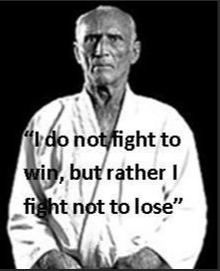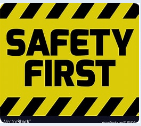
After dedicating countless hours to training in the dojo, you’ve honed your skills and built confidence in your abilities. Rigorous practice equipped you with formidable self-defense techniques and sculpted your physique into its peak condition.
As you step out of the safety of the dojo and into the busy streets, the true test of your training awaits in the concrete jungle where threats can emerge from unexpected corners. Are you ready to adapt your skills to the unpredictable nature of street encounters?
Know enough survival to be dangerous.
Dangerous to yourself. It is a common occurrence. A new student, we’ll call him James, is unsure of himself and of this art he’s learning. Through training, his confidence grows. He begins to wonder if this stuff really works. With increasing confidence James comes to believe in his ability to confront the bully who sent him to karate class in the first place. Fueled by this newfound self-assurance, he feels he is ready for his bully the next time they cross paths.
It is with great joy that a sensei hears the words, “This stuff really works!” James beams as he tells the story of how he saw the punch coming and just reached out and deflected it. Then he punched the bully back. “Startled,” he said, “This time the bully ran away from me!” James was schooled in Funakoshi’s rule that “there is no first attack in karate.” James learned his lesson well and waited for the bully to attack him first.
Karate Ni Senti Nachi for Street Survival

It is drilled into your head. Karate is a defensive art. You wait for the attack to come to you. Not everything you learn in the dojo fits to real life, in case you haven’t figured it out. Training in the dojo teaches you reaction skills, to think on your feet, to act first and think later. This comes from the rigorous repetition of techniques. Over and over again. How many times has your sensei said, “Again.”
Again and again. Training muscle memory.
You’re coached to stay vigilant of your environment, using peripheral vision and minimizing distractions, like not to use your cellphone in a busy public place. Through practice, you cultivate a confident demeanor that inadvertently deters potential threats. Though you are not confrontational, your self-assurance often discourages would-be muggers from targeting you.
But it’s a jungle out there. There is always one person who trains harder than you. One person who is stronger than you. Even black belts get attacked and beat up. The belt you wear around your waist is no guarantee of success. What happens when you come upon a group of thugs who want to knock your attitude down a notch or two? Will you be able to “fight not to lose?”
There are rules and then there are rules. The idea behind no first attack is to develop character and teach you different ways to deescalate a threat besides fisticuffs. But sometimes, rules are made to be broken, and if you feel your life is in danger, there is only one rule. You fight to not lose.
Seven Essential Street Survival Tactics
-
Unconventional Tactics: Embracing “Dirty Fighting” for Survival
When fighting for your life, you do what it takes to dissuade your attacker and remove yourself from the threat. Use whatever is at hand to accomplish this. Lamps, chairs, rocks, sticks. You have no time to think, this confrontation will be over in a few seconds. Do what you can to overcome your attacker.
-
Seizing Control: Pressing the Offensive
To press the offensive means to attack first! Attack the attacker. This is where you distinguish between your dojo training and your will to survive. When someone attacks you, your very first move may or may not be a defensive move, but the goal is to do whatever it takes to get the hell out of there!
Don’t let the guy get a bear hug on you before you decide he’s a threat. You’ve developed your perceptions – eyes in the back of your head. Use them. When you sense danger, react. If someone comes up behind you, you can feel him getting close. If you turn and see him coming at you aggressively, he hasn’t touched you yet but he’s within your boundary of a perceived threat, use this chance for a heel palm to the nose, before he knows what’s coming.
-
Targeting Vulnerabilities: Prioritizing Vital Strikes
Which brings us to target points. There are 108 vulnerable points on the body that are easily reached. If you have been on the receiving end of any of these, you are aware of how instantly disabling they are. When you are in a street fight, however, it is not always easy to reach some of these points. The assailant may be wearing a heavy coat, for instance. The following charts show you 32 of these points. With this arsenal at hand, you know where to aim for the most vulnerable areas.

-
Tactical Advantage: Employ Surprise Attacks
You practice feinting in the dojo – fake low, go high. Don’t forget to use this when you are in an attack situation. Look away as though someone’s behind your assailant; double over in pain; act like a fool. Whatever it takes.
Surprise them! Keep them on their toes. Musashi calls it “mountains and valleys.” When they come in high, you go in low. If you try a technique that doesn’t work, change it up. Stay on top of the game and watch for openings.
-
Constant Vigilance: Never Expose Your Back
So many self-defense videos show the girl thwarting her attacker and then running away. This is crazy.
Make sure your exit is clear so when you do run away, you encounter no other danger. However, do not turn your back and run away. Step back. Keep your hands open in a defensive position and back, back away. If you practice distancing in the dojo, closing the gap in one step, or backing away without your opponent realizing it; this is the same principle. Try to cover ground without them noticing. If they are down, good job on your part, but assume they could suddenly recover and come after you. When you do run away, run backwards until you are a safe distance from the threat.
-
Knife Awareness: Understand the Dangers
Many assailants like to carry knives. Much more efficient than a gun and easier to conceal. Muggers like to work up close and personal, and a gun is not suited for close-in quarters. What do you do if someone comes at you with a knife?
First of all, don’t let him get close enough to grab you and put it against your throat. It is a little bit too late then to do anything but relent to his wishes – and hope he isn’t serious about cutting you. You are using the skills you learned in the dojo so hopefully that won’t happen. You are aware of your surroundings and when you see someone suspicious, you keep your eye on them.
If someone has a knife in their hand, expect to get cut. Keep the inside of your forearms toward your body at all times. The outside of your arm has fewer major blood vessels, and you can cover most of your chest and abdomen with a forearm. Practice blocking a knife in the dojo. Adapt knives as one of your weapons. My favorite weapon is a knife. I’ve practiced with live blades, and yes, I’ve been cut. Guess what? Getting cut isn’t the end of the world. Disarm the knife from your attacker as quickly as you can. Don’t be a hero.
-
Strategic Engagement: Managing Group Attacks with Singular Focus
Managing a group of thugs can get interesting. But if you watch a group fight, generally the entire bunch doesn’t gang up in a dog pile. There are only one or two brave enough to come after you, and the rest hang back. Look for the leader. Make eye contact. Give him the nonverbal message that you have no desire to deal with him. Watch his body language. Show no fear. Chances are he will let you pass on by.
But if not, you can only deal with one person at a time. Use the first one to distance yourself from the others. Put him between you and as many of his buddies as possible. Quickly disable the first attacker and use that moment of opening to back away. Try not to let the group surround you.
-
Emergency Response: Actions to Take in Critical Situations
The trick in getting away from any self-defense situation is to make sure you know your escape exit is clear. There’s a big wave now of “you are what you think, and if you think bad thoughts, you will go there.” In some cases that is true.
In the case of self-defense though, it is never “bad thoughts” to visualize situat ions and how you would handle them. Defending yourself on the street is no different than learning a kata. When doing kata, you use your imagination and see different scenes of attack and defense as they apply to the moves in that kata.
ions and how you would handle them. Defending yourself on the street is no different than learning a kata. When doing kata, you use your imagination and see different scenes of attack and defense as they apply to the moves in that kata.
Mentally rehearsing what you would do in a situation if you were attacked is no different. They say the martial arts is 90% mental and 10% physical. This is what that means. You spend 90% of your time thinking of your training, 10% in actual physical training, and >0.10 of this time defending yourself.
This is the time to believe in your training. Now is not the time to panic. Stay focused on the moment and rely on your instincts.
Save the nerves, the shakes, the self-doubts, the “I should haves” for after you are away from your threat. Then as you are shaking in your shoes, trying to calm down, then is the time to review what you did and should have done, and be grateful for your excellent training.
There you have it. Eight survival tactics you can rely on if you are caught in the concrete jungle – urban living. But even though your chances of getting attacked are less if you live in a rural area, you never know who’s lurking behind those bushes!
Take care and be aware.
Sensei Carol

